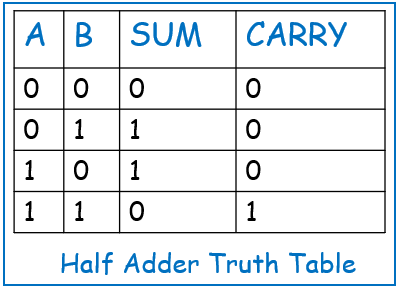In the realm of digital electronics, the ability to perform arithmetic operations is crucial. Among the fundamental components that enable these operations are adders, with the Half Adder being one of the simplest yet essential types. This blog will explore the Half Adder, its components, functionality, and significance in digital circuit design.
What is a Half Adder?
A Half Adder is a digital circuit that performs the addition of two single-bit binary numbers. It produces two outputs: a sum bit and a carry bit. The simplicity of the Half Adder makes it a fundamental building block for more complex arithmetic circuits, such as Full Adders and arithmetic logic units (ALUs).
Theoretical Background
Before delving into the Half Adder, it is essential to understand the basics of binary addition. In binary arithmetic:
- 0 + 0 = 0
- 0 + 1 = 1
- 1 + 0 = 1
- 1 + 1 = 10 (which is 0 with a carry of 1)
Components of a Half Adder
A Half Adder consists of two primary components:
- XOR Gate: Produces the sum bit.
- AND Gate: Produces the carry bit.
The logical expressions for the outputs are:
- Sum (S) = A XOR B
- Carry © = A AND B
Circuit Diagram
The circuit diagram of a Half Adder is straightforward, with an XOR gate and an AND gate connected as shown below:

Truth Table
The truth table below illustrates how the Half Adder operates for all possible input combinations:

Applications of Half Adder
Half Adders are fundamental components in digital electronics and have several applications, primarily in the construction of more complex arithmetic circuits. Here are some key applications:
- Building Full Adders: Half Adders are used to construct Full Adders, which can add binary numbers of more than one bit. A Full Adder adds three bits (two significant bits and a carry bit) and produces a sum and a carry bit. By cascading multiple Full Adders (which themselves are built from Half Adders), you can create circuits capable of adding multi-bit binary numbers. This forms the basis of ripple-carry adders and other multi-bit adder architectures.
- Arithmetic Logic Units (ALUs): Half Adders are integral to the design of ALUs, which perform a variety of arithmetic and logical operations in microprocessors and digital systems. ALUs use Half Adders and Full Adders to perform binary addition, which is a fundamental operation in computing.
- Digital Signal Processing (DSP): Efficient Data Manipulation: In DSP applications, Half Adders are used for efficient data manipulation and processing tasks that require binary addition. Simple binary calculators use Half Adders to perform basic addition operations. They serve as the foundational units that enable binary addition in these devices.
- Memory Address Calculation: In memory systems, Half Adders help in the calculation of memory addresses during read and write operations, ensuring data is stored and retrieved correctly.
- Digital Counters: Half Adders are used in digital counters, where they help in performing the increment operations necessary for counting sequences.
- Encoders and Decoders: In encoders and decoders, Half Adders assist in converting data between different binary codes, which is essential in various digital communication and storage systems.
- Error Detection and Correction: Half Adders are used in generating checksums for error detection and correction in data transmission. They help in adding binary values to produce checksums that verify data integrity.
Conclusion
The Half Adder is a fundamental component in digital electronics, serving as a building block for more complex arithmetic circuits. Its simplicity and essential role in binary addition make it a critical topic for anyone studying digital logic design. Understanding the functionality, applications, and implementation of the Half Adder provides a solid foundation for exploring more advanced digital circuits.
For those interested in practical implementations, I have detailed blogs on how to implement a Half Adder using both VHDL and Verilog on Xilinx Vivado. Click on the links below to explore the full implementations and testbench code:
Stay tuned for more detailed blogs on combinational circuits and other key topics in digital electronics.



